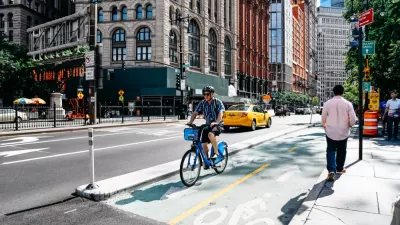New York City has several famous examples of pedestrian-only environments, but last weekend's Shared Streets event was an experiment in co-existence.
"DOT’s first-ever “Shared Streets” event limited car traffic entering a 60-block section of the Financial District for five hours on Saturday. With the neighborhood free of the near-constant stream of cars passing through on a typical day, pedestrians and cyclists were free to navigate the streets without fear," writes David Meyer.
In choosing the shared streets model instead of closing the streets down entirely to cars, New York's experiment hopefully offered lessons for people on either side of the driving wheel. For those outside of cars, the event offered new access to the streets of Manhattan. The day also (hopefully) showed drivers that they can still get where they're going at a pace safe for all users. The Meyers article also includes a lot of photos of New Yorkers (and a few tourists, presumably) making use of the streets of Manhattan in new ways.
Tom Kutsch also reported on the Shared Streets day in a separate article, noting especially the list of policy outcomes such events are intended to advance—such as improved pedestrian and bike safety and reduced air pollution and carbon emissions.
The city has yet to announce whether the Shared Streets event has a future in New York. Both articles report low turnout due to sweltering heat on the day of the event.
FULL STORY: First-Ever “Shared Streets” Brings Stress-Free Streets to Financial District

Study: Maui’s Plan to Convert Vacation Rentals to Long-Term Housing Could Cause Nearly $1 Billion Economic Loss
The plan would reduce visitor accommodation by 25,% resulting in 1,900 jobs lost.

North Texas Transit Leaders Tout Benefits of TOD for Growing Region
At a summit focused on transit-oriented development, policymakers discussed how North Texas’ expanded light rail system can serve as a tool for economic growth.

Why Should We Subsidize Public Transportation?
Many public transit agencies face financial stress due to rising costs, declining fare revenue, and declining subsidies. Transit advocates must provide a strong business case for increasing public transit funding.

How to Make US Trains Faster
Changes to boarding platforms and a switch to electric trains could improve U.S. passenger rail service without the added cost of high-speed rail.

Columbia’s Revitalized ‘Loop’ Is a Hub for Local Entrepreneurs
A focus on small businesses is helping a commercial corridor in Columbia, Missouri thrive.

Invasive Insect Threatens Minnesota’s Ash Forests
The Emerald Ash Borer is a rapidly spreading invasive pest threatening Minnesota’s ash trees, and homeowners are encouraged to plant diverse replacement species, avoid moving ash firewood, and monitor for signs of infestation.
Urban Design for Planners 1: Software Tools
This six-course series explores essential urban design concepts using open source software and equips planners with the tools they need to participate fully in the urban design process.
Planning for Universal Design
Learn the tools for implementing Universal Design in planning regulations.
City of Santa Clarita
Ascent Environmental
Institute for Housing and Urban Development Studies (IHS)
City of Grandview
Harvard GSD Executive Education
Toledo-Lucas County Plan Commissions
Salt Lake City
NYU Wagner Graduate School of Public Service





























